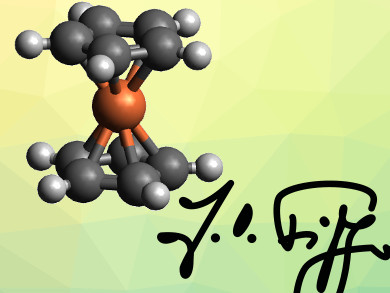Ernst Otto Fischer was born on November 10, 1918, in Solln near Munich, Germany. He started to study chemistry in 1941—during leave from military service—at the Technical University of Munich and continued his studies after the end of World War II. He completed his Ph.D. in inorganic chemistry there in 1952 under the supervision of Walter Hieber.
Ferrocene had just been independently discovered by both Thomas J. Kealy and Peter L. Pauson, Duquesne University, Pittsburgh, PA, USA [1], and Samuel A. Miller, John A. Tebboth, and John F. Tremaine,  British Oxygen Company, UK [2]. However, the researchers had proposed an incorrect structure for the compound (pictured right).
British Oxygen Company, UK [2]. However, the researchers had proposed an incorrect structure for the compound (pictured right).
Working independently, both Ernst Otto Fischer [3] and a team including Robert Burns Woodward and Geoffrey Wilkinson, Harvard University, Cambridge, MA, USA [4], discovered the correct structure: a sandwich complex (pictured above), the first example of this type of compound. Woodward and Wilkinson had used infrared spectroscopy, magnetic properties, and the compound’s reactivity to deduce the structure. Fischer had performed X-ray crystallography. In 1953, he achieved the first syntheses of the related sandwich compounds cobaltocene and nickelocene [5,6].
In 1954, Fischer completed his habilitation at the Technical University of Munich and started teaching there. The following year, he synthesized another important sandwich complex for the first time, bis(benzene)chromium [7]. In 1957, he joined the Ludwig-Maximilians-University Munich (LMU) and became Full Professor there in 1959. In the 1960s, Fischer developed a synthesis for stable metal carbene complexes, which are named Fischer carbenes in his honor [8]. In 1964, Fischer became Professor of Inorganic Chemistry at the Technical University Munich and, thus, successor to his teacher Walter Hieber. He remained there until his retirement in 1985.
The Nobel Prize in Chemistry 1973 was awarded jointly to Ernst Otto Fischer and Geoffrey Wilkinson “for their pioneering work, performed independently, on the chemistry of the organometallic, so called sandwich compounds.” Ernst Otto Fischer died on July 2007 in Munich, Germany.
Ernst Otto Fischer is the answer to Guess the Chemist (83).
References
- [1] A New Type of Organo-Iron Compound,
T. J. Kealy, P. L. Pauson,
Nature 1951, 168, 1039–1040.
https://doi.org/10.1038/1681039b0 - [2] Dicyclopentadienyliron,
Samuel A. Miller, John A. Tebboth, John F. Tremaine,
J. Chem. Soc. 1952, 632–635.
https://doi.org/10.1039/JR9520000632 - [3] Cyclopentadien-Metallkomplexe, ein neuer Typ metallorganischer Verbindungen (in German),
E. O. Fischer, W. Pfab,
Z. Naturforschung B. 1952, 7, 377–379. - [4] The Structure of Iron Bis-Cyclopentadienyl,
Geoffrey Wilkinson, M. Rosenblum, M. C. Whiting, R. B. Woodward,
J. Am. Chem. Soc. 1952, 74, 2125–2126.
https://doi.org/10.1021/ja01128a527 - [5] Di-cyclopentadienyl-kobalt(II) (in German),
E. O. Fischer, R. Jira,
Z. Naturforschung B. 1953, 8, 327–328. - [6] Di-cyclopentadienyl-nickel (in German),
E. O. Fischer, R. Jira,
Z. Naturforschung B. 1953, 8, 217–219. - [7] Di-benzol-chrom. Über Aromatenkomplexe von Metallen I (in German),
E. O. Fischer, W. Hafner,
Z. Naturforschung B. 1955, 10, 665–668. - [8] Zur Frage eines Wolfram-Carbonyl-Carben-Komplexes (in German),
E. O. Fischer, A. Maasböl,
Angew. Chem. 1964, 76, 645–645.
https://doi.org/10.1002/ange.19640761405
Sources
- Ernst Otto Fischer: Biographical,
Nobel Lectures, Chemistry 1971-1980,
World Scientific Publishing Co., Singapore, 1993. - 3.0.CO;2-2″ target=”_blank”>https://doi.org/10.1002/(SICI)1521-3757(20000103)112:1<127::AID-ANGE127>3.0.CO;2-2
Also of Interest
- At Least 60 Years of Ferrocene,
Jonathan Faiz,
ChemViews Magazine 2012.
An Essay by Helmut Werner in Angewandte Chemie outlines the discovery of sandwich complexes




